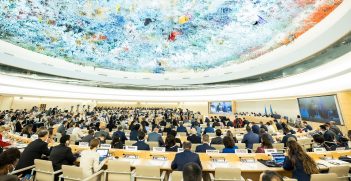The BRICS Resurgence

Once widely dismissed as irrelevant, the BRICS bloc has seen a resurgence amid the Russian invasion of Ukraine and rising US-China tensions. As the bloc increasingly morphs into a tool to advance the interests of Russia and China, it poses a growing threat to the liberal international order.
Given their conflicting interests and mutual distrust, sceptics have long questioned the ability of the BRICS (Brazil, Russia, India, China and South Africa) to translate their economic might into collective power on the international stage. Many dismissed the bloc as merely a “mirage” and expected it to fade into irrelevance as growth rates slowed across the grouping. Instead, however, what has occurred in recent years is just the opposite: a resurgence of the BRICS amid growing geopolitical tensions and a significant expansion of the group’s membership.
The concept of the BRICs originated in a 2001 Goldman Sachs investment report predicting that rapid growth would significantly increase the economic weight of these countries. Such projections proved largely accurate, with the BRICS’ share of global GDP rising from 8 percent in 2001 to 26 percent today, while that of the G7 group of advanced economies fell from 65 percent to 43 percent. Over time, what started as an economic phenomenon evolved into a political club, intended to rival the G7. The BRICs foreign ministers began meeting in 2006 and the group held its first Leader’s Summit in 2009. South Africa was added to the group in 2010.
There is no question that the BRICS are a highly heterogeneous group. Many have questioned whether Russia even belongs in a group of “rising” powers when it is more accurately a declining power since the collapse of the Soviet Union. Three of the group’s members – Brazil, India, and South Africa – are democracies, while the remaining two – Russia and China – are autocracies. Russia, China, and India possess nuclear weapons, while Brazil and South Africa do not. Although Russia and China are permanent members of the UN Security Council, they have opposed the other BRICS’ proposals to gain permanent seats.
In economic terms, China dwarfs the other BRICS – its economy is larger than the other four combined. This disparity has soared over the past two decades: China’s share of the BRICS’ collective GDP was 47 percent in 2001; today it is 70 percent. While many BRICS have profited from booming trade with China, they are also concerned about growing economic dependence on China, as well as the impact of cheap Chinese imports on their manufacturing sectors. This is just one of the reasons that unfavourable public opinion towards China has been rising in several of the BRICS.
The bilateral relationship between two of the biggest powers within the group – India and China – is rife with friction. India is acutely anxious about China’s growing role in its region, and longstanding tensions over their disputed border have erupted into violent clashes in recent years. In addition, India’s trade deficit with China has exploded over the past 20 years, becoming a further source of tension. The two are also often seen as rivals competing for leadership of the Global South.
Despite these myriad sources of tension and division among the BRICS, what fundamentally unites the group is a political agenda of challenging US or Western dominance of the international order. The BRICS share a strong sense of historical grievance and an oppositional identity vis-à-vis the G7. They are each seeking greater status, prestige, and influence on the international stage, and are eager to cultivate allies that will strengthen their position relative to the established powers.
It is important not to overestimate the power capabilities of the BRICS, even in strictly economic terms. BRICS boosters have touted the fact that the group overtook the combined GDP of the G7 at PPP rates in 2020. But while PPP is useful to compare the standard of living across countries, it is irrelevant from the perspective of economic power. What matters for state power is aggregate economic might – in other words, actual GDP rather than GDP measured in PPP terms. By this measure, the G7 still remains 65 percent larger than the BRICS. Moreover, the growth of the BRICS has been overwhelmingly driven by China, but predictions that China would overtake the US as the world’s largest economy within the next decade have now evaporated due to a dramatic slowdown in its growth rates.
This does not mean that the BRICS should be dismissed. On the contrary, the significance of the BRICS as a political force on the global stage has recently been demonstrated following the Russian invasion of Ukraine. The BRICS have refused to condemn Russia’s military aggression, or to join the West in imposing sanctions on Russia, which are intended to undercut its ability to wage war by hitting its economy. Russia’s trade with the BRICS has soared, enabling it to mitigate the effects of Western sanctions. China is now the biggest buyer of Russian energy, and its imports from Russia have doubled. India continues to buy oil and weapons from Russia, with its imports from Russia soaring by over 400 percent. Brazil is the largest purchaser of Russian fertilizer – one of its most important exports after energy – and its trade with Russia has more than doubled. The BRICS are still welcoming Vladimir Putin to their summits, stressing their “solidarity” and “friendship” with Russia in their public statements, and parroting Russian narratives about the war. The BRICS have thus directly undermined international efforts to isolate and ostracize Russia.
As demonstrated in their response to the Russian invasion of Ukraine, the ties among the BRICS have proven far stronger than anyone expected. And, far from withering, the bloc is now expanding. Reportedly, over 40 countries are seeking to join the group, many suspected of primarily seeking to gain easier access to Chinese investment and financial support. Both China and Russia are strongly in favour of BRICS expansion. Like Russia, China is equally keen to avoid isolation and bolster its alliances as tensions with the US and other Western powers grow. Despite concerns among the other BRICS that expansion risks turning the group into a China-centric club, they have agreed to admit six new members – Saudi Arabia, Argentina, Egypt, Ethiopia, Iran and United Arab Emirates – as of next year. Of these, only Argentina is a democracy, meaning that enlargement will leave the group dominated by non-democratic countries.
When the BRICS grouping was created nearly two decades ago, many hoped it could serve as a counterweight to the G7 and help democratise the global order by giving greater voice and influence to the Global South. But instead, the group increasingly appears to be morphing into a tool to advance the interests of authoritarian Russia and China, posing a growing threat to the liberal international order.
Kristen Hopewell is Professor and Canada Research Chair in Global Policy at the University of British Columbia.
This article is published under a Creative Commons License and may be republished with attribution.





